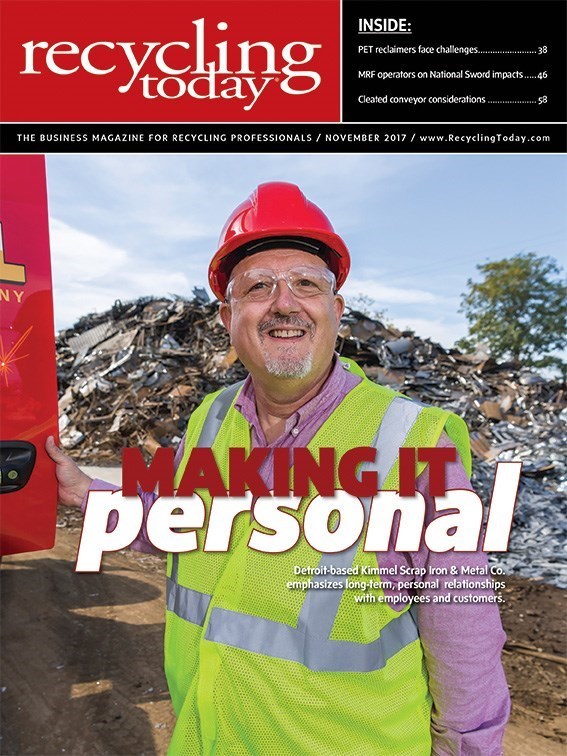
The Chinese government recently has taken noteworthy actions that are significantly disrupting recovered paper markets in the United States, said several speakers in sessions at the 18th annual Paper & Plastics Recycling Conference, held in Chicago Oct. 11-13, 2017.
Speakers discussed the steps the Institute of Scrap Recycling Industries (ISRI), Washington, has taken to address China’s scrap import ban on mixed paper as well as moves material recovery facility (MRF) operators have made, from slowing down lines to adding sorters, to address quality issues. Cleaning up quality is a must.
In the Indexes and Trading Platforms session, Greg Rudder, editor of PPI Pulp & Paper Week, published by the Boston-based research firm RISI, explained the methodology behind its pricing.
Rudder also shared the history of mixed paper shipments from the U.S. to China. Citing information from the Washington-based American Forest & Paper Association (AF&PA), he said the U.S. shipped the lowest total tons of mixed paper to China last year since 2002. In 2016, the U.S. shipped 2.37 million tons of this material to China, a drop from the 3.07 million tons shipped in 2015 and from the high of 5.63 million tons shipped in 2009. (A total of 1.86 million tons of mixed paper were shipped in 2002.)
In April 2017, mills in China reported that imported mixed paper contained 20 percent contaminants, on average, Rudder said.
Linda Leone, regional vice president of recycling for the Northeast U.S. and eastern Canada at WestRock Co., Norcross, Georgia, acknowledged change was needed. She served as moderator for the ISRI Paper Stock Industries (PSI) Chapter session, The Future of Mixed Paper. Speakers featured in that session were Johnny Newsome, director, global mill supply and trade sales, Sonoco Recycling, Hartsville, North Carolina; Bob Cappadona, vice president of Casella Recycling, Rutland, Vermont; Pieter Eenkema van Dijk, CEO of Van Dyk Recycling Solutions, Stamford, Connecticut; and RISI’s Rudder.

Leone said, “While the future of mixed paper is unclear as it relates to China, we know it needs to evolve.”
Casella’s Cappadona said contaminants in loads arriving at MRFs are a safety and time issue. He said more needs to be done to ensure cleaner incoming streams of recyclables.
“I don’t think there’s any doubt from an operator’s perspective that we’re going to have to get better,” Cappadona said. He referenced The Tortoise and The Hare fable when he said, “The turtle wins the race; it’s OK to slow down [the line].”
Sonoco Recycling’s Newsome offered some light amid the darkness surrounding mixed paper’s outlook. He said MRFs will improve their sorting capabilities and mixed paper will endure as a grade.
“Mixed paper will always be a product of residential programs, even if at a higher cost,” Newsome said.

He projected new global consuming capacity for this grade will grow 2.2 percent.
In addition, as China tightens its restrictions, Newsome said mixed paper recovered in the U.S. will be exported to other countries where consumption capacity is increasing.
Rudder said Vietnam and India are interested in this recovered fiber grade. He noted that one-third of mixed paper shipped from the U.S. goes to countries besides China.
“Demand for recovered paper will grow at a higher rate than collection,” he added.
Newsome said, “The mixed paper situation is a short-term issue with a long-term solution.”
Beyond the export market, he said domestic MRFs will run mixed paper at slower line speeds to improve quality and also will make investments in sorting equipment and personnel to facilitate this improvement. He said he thinks mills will be willing to pay more for cleaner mixed paper as the material would still come at a lower cost than old corrugated containers (OCC).

Explore the November 2017 Issue
Check out more from this issue and find you next story to read.
Latest from Recycling Today
- Bridgestone introduces retreating plant virtual tour
- USTMA announces Tire Recycling Foundation
- Dow announces agreement with Freepoint and MOU for Asia Pacific market with SCGC
- Mixed signals chracterize ferrous market
- Researchers look into ironing out a secondary aluminum limitation
- Analysis: Chemical recycling’s ‘inflection point’ nearing
- Machinex system in Québec targets organics diversion
- Northern Shenandoah region awarded $3.9M for recycling infrastructure





